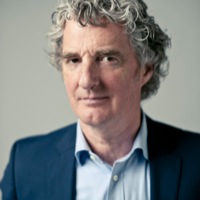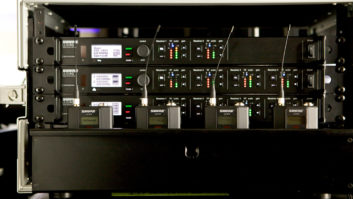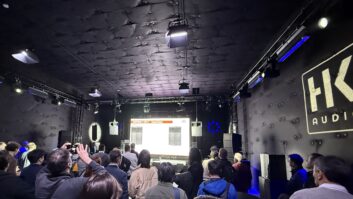
TURN back through the pages of history: it is spring 2009 and the prospects for licensed PMSE (programme making & special events) usage of wireless audio systems in applications ranging from live touring to houses of worship appear decidedly bleak.
As spectrum sell-off draws closer, a future ‘home’ for the sector has yet to be finalised in the UK and many mainland European countries, while the ever-powerful IMT (international mobile telecommunications) community is flexing its muscles and calling for space to accommodate next-generation mobile services. Time-consuming – and costly – lobbying efforts have raised the profile of pro-audio’s case, but a scenario in which large-scale wireless audio system operation is rendered challenging or even impossible does not seem unduly far-fetched. Move forward three years and the outlook for PMSE is rather brighter. Future licensed spectrum access has been guaranteed in a number of European countries, while the UK and Germany have led the way in proposing (albeit limited) funding schemes to help users update their wireless audio stocks. In more general terms, “the PMSE case is much higher up the agenda these days,” observes Alan March, business development specialist at Sennheiser UK and a prime mover within the BEIRG (British Entertainment Industry Radio Group) Pro-User Group. Any moves to uncork the champagne would be premature, however. As March also notes: “The pressure on spectrum is only going one way – towards increased congestion.” The emerging mobile broadband networks will constitute one significant component of the great spectrum squeeze – but so too will so-called ‘white space devices’ (WSDs). The latter will also facilitate new internet services, but will operate by identifying unoccupied spectrum with reference to databases containing information about licensed users. Enormous revenue potential means that the momentum behind WSDs is growing by the day, and with the technology behind them still in its infancy, their implications for wireless audio are beginning to preoccupy many of the sharpest minds in the PMSE community. The need for extensive testing means that it is unlikely we will not witness the large-scale roll-out of WSDs until 2014 at the earliest. More imminently, this summer’s Olympic and Paralympic Games may provide some welcome insight into the spectrum-intense future that awaits us all. “[UK communications regulator] Ofcom has taken on the responsibility for managing spectrum during the Games, so the results of the [RF assessment] will be staring them in the face,” says March, who believes the Olympics could be a “very interesting moment” in terms of determining the future direction of the entire spectrum debate.
An Ofcom spokesman says: “Ofcom, LOCOG and the UK government have made extensive preparations… to fulfil the government’s guarantee to the IOC that sufficient wireless frequencies would be made available to meet the needs of the Games,” observing that the Opening and Closing Cermonies will see intensive spectrum use. “Most users, including those for the Ceremonies, have now submitted their requirements and we have started issuing their licences. Ofcom will be deploying an extended team of experts throughout the Games to deal with any interference that might occur.” Lands of confusion?The long-term process of reallocating and auctioning off the 800MHz spectrum to make way for new mobile services is a Europe-wide phenomenon, but the way in which governments have addressed the needs of PMSE users has been subject to considerable variation. Similarly, the pace at which individual nations have moved through the process hasn’t exactly been consistent. For example, while UK pro-users will lose their channel 61-69 (790-862MHz) permissions from 31 December 2012, access rights in some other European countries won’t change until 2014 or even later. The upshot is that the map of future licensed PMSE spectrum usage is still rather confused. Augmenting existing unlicensed options, France, Germany, the Netherlands and the UK have all made significant progress in safeguarding future licensed radio microphone access. In France, radio mic usage is licence-exempt, but new rules due to be published in the next few months are expected to specifically identify the secondary availability of interleaved spectrum (white spaces) in the UHF band of 470-790MHz. In Germany – where Sennheiser Vertrieb & Service GmbH president Ties-Christian Gerdes recently estimated that “up to 700,000 wireless microphones” could be affected – pro-users can access a new licensed core PMSE spectrum of 710-790MHz, while the registration-free operation of radio links is possible in certain blocks of the former UHF spectrum until 31 December 2015, provided that frequency area is not being used by mobile services. In the Netherlands, it is widely expected that UHF channels 39, 40 and 41 will be assigned to radio microphones on a secondary basis with DVB-T (Digital Video Broadcasting – Terrestrial). Meanwhile, in the UK, PMSE users have confirmed access to channel 38 – previously occupied by radio astronomy – while channel 70 remains an option for unlicensed operation, although the latter offers no guaranteed protection from interference. So far, so (reasonably) good – but the situation in many other European countries is more unsettled. Dré Klaassen (pictured), president of APWPT (Association of Professional Wireless Production Technologies) and a wireless audio specialist at Audio-Technica, confirms that political machinations have reduced the entire process to a crawl in Italy: “The Digital Dividend is decided, but everything is going very slowly.” In Spain, there is enduring confusion about the rules for the use of radio mics on a secondary basis in the UHF band (“the legal situation there is very confusing”), while the authorities in some Eastern European countries are not yet “fully aware of PMSE and the impact it has on society”, argues Klaassen.
“There are a lot of threads to the radio microphone spectrum [issue] and a lot of lobbying work will be required during the next three to four years to ensure that we have some UHF TV band left for radio microphones beyond 2020.” System sale resurgenceThe extent to which governments have sought to assist PMSE users to update or replace equipment rendered inoperable by the changes is more easily defined – simply put, most haven’t. To date, the UK and Germany are the only countries to have signed off on funding schemes, but in both cases they only cover a limited amount of equipment. In Germany, the (ongoing) package devised by the federal ministries of economies/technology and finance requires aspiring claimants to have purchased their wireless microphone systems between 1 January 2006 and 31 December 2009; they must also offer qualified proof of an impact from LTE (4G) mobile phone networks. Meanwhile, in the UK, a 2010 scheme announced by Ofcom and administered by Equiniti delivered around 55% of the expenses accrued from replacing or converting licensed channel 69 systems rendered inoperable by spectrum reallocation. Although a testament to the lobbying efforts of BEIRG and other industry groups, the UK initiative wasn’t an unqualified success: other 800MHz band PMSE equipment was excluded, while news of plans to resell some old systems surrendered under the payment scheme caused uproar when details emerged during PLASA 2011. Despite these not insignificant caveats, most wireless audio manufacturers and distributors agree that the payment schemes have contributed usefully to an increase in system sales over the past 12 months. March admits that Sennheiser UK effectively enjoyed “three years’ worth of sales in a single year – but you do have to see that in the context of the previous few years, which were challenging as there was so much uncertainty”. Peter James, managing director of Shure Distribution UK, remarks that plenty of money has been spent on new systems since the outlook for British users assumed greater clarity, but he “would not say that investment is any greater. If anything, rental companies have taken the opportunity to rationalise total inventory.” Whatever the variations, manufacturers have universally expended considerable time and effort on developing systems that are conducive to post-changeover conditions. For example, UK users now have an array of channel 38-compliant systems from which to select. All Shure wireless products, notes James, have been available in UK-optimised channel 38 variants since early 2011 and some since 2010. Audio-Technica’s 700, 2000 and 3000 series are all channel 38-operable, while Sennheiser’s compliant systems include the G3 GB. UK distributor Sound Technology confirms that all of AKG’s professional wireless range can now work in the channel 38-40 spectrum, while TOA’s new 5000 series mics provide channel 38 operability. Trantec offers “nearly all” of its range in either channel 38 or 70… and that is barely to scratch the surface of the currently available offers. With non-channel 38 options also viable for many users, pro customers are hardly lacking in choice when it comes to investing in new wireless systems – but is there still a danger that some are unaware of the forthcoming changes’ full implications? By general consent, the combined efforts of trade groups, individual manufacturer guides/seminars, and extensive press coverage mean that understanding of the issue is now good-to-excellent in many areas of the pro community. Even so, Peter James isn’t alone in admitting surprise at “the occasional wayward interpretation of the changes and future spectrum reallocation”, while Hans Kolberg’s James Knight has some very specific concerns about houses of worship (see box, right). Beware the WSDs?While the loss of the 800MHz spectrum has been a done deal for many years, discussion at the most recent World Radiocommunication Conference (23 Jan-17 Feb) raised the prospect of a 700MHz spectrum auction in Africa – a move that could trigger a similar sell-off in Europe, which is also in Region 1. But murmurings since the WRC lead March to believe that the plans may not receive the go-ahead: “There is a feeling that it would be more beneficial [economically] to instead have more interleaved frequencies and go down the shared access route – of which WSDs would be a part.” The extent to which WSDs might impact on PMSE services remains open to debate. Neul – a Cambridgeshire-based consortium whose director of technology officer is former Ofcom director of technology resources, Professor William Webb – is among the organisations to be enthusing about the technological and commercial possibilities of WSDs. But, says March, a recent trial in Cambridge in which he participated “raised some very serious questions about whether these devices can successfully co-exist alongside PMSE and DTT [digital terrestrial television] services without causing disruption. We had been warning Ofcom for a long time about the possible effect of WSDs, and I think there is now a greater recognition of the problems that might occur.” Across the board, manufacturers and distributors pay tribute to the efforts of BEIRG and other groups in encouraging governments to “realise how important the PMSE community is to the economy and [everyone ’s] cultural needs”, in the words of Trantec’s Tony Cooper. But the future trajectory is clear: WSD implementation – although years away – will bring further pressure on spectrum, while pro customers will need to rely more extensively on licensed operation as unlicensed users will be absent from WSD databases and will therefore not be protected from interference deriving from adjacent channels. The impact of individual developments is difficult to ascertain, but – at the very least – PMSE is going to have to ‘box clever’ as some other groups’ appetite for spectrum becomes ever more insatiable. www.akg.comwww.apwpt.orgwww.audio-technica.comwww.beirg.co.ukwww.hans-kolberg.co.ukwww.ofcom.org.ukwww.riedel.netwww.sennheiser.co.ukwww.shuredistribution.co.ukwww.soundtech.co.ukwww.toa.euwww.trantec.co.uk







